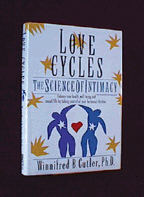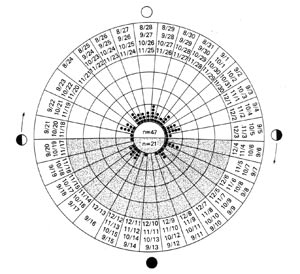An excerpt from Dr. Winnifred Cutler's book,
Love Cycles: The Science of Intimacy
Chapter 8:
Cosmic Cycles - Lunar Events

This chapter relays Dr. Cutler's path to discovering the lunar influences on a woman's cycle and, in turn, reproduction.
" The lunar cycle and a fertile menstrual cycle
are the same, 29.5 days... A real phenomenon exists"
Click here for more of Dr. Cutler's lunar presentations:
Lunar Influences on the Reproductive Cycle in Women
Click here for more on increasing romantic attention and pheromone research.
Pp 212- 239 excerpted. For entire book information click here
Introduction:
Even a shallow consideration of the cycles of the moon and of men and women triggers the idea that human cycles and lunar cycles have something in common and that both men and women are involved in the process. Even trouble comes in cycles. The numbers of suicides, hospital emergencies and other crises rise at the full moon. Lunacy is a real phenomenon, and aptly named. And recently published studies have begun to prove it.
The Magic of 29.5 Day Cycles
Rigorous research by physicists has shown that the moon becomes full with predictable regularity just about every 29.5 days. Similarly, rigorous research by reproductive biologists reveals that the average menstrual cycle among fertile women is usually 29.5 days long. The moon cycle coincides in length with the average menstrual cycle. This coincidence has biological significance and is non random.
The hormonal cycle of a fertile woman is an exquisitely complex symphonic interrelation between events in her own body and interactions with her lover. The pulse beat of this symphony is further controlled by larger, cosmic forces. Many of us sense the inevitability of such a reality. The astrologer, the philosopher, the biologist, and the religious person each in his or her own way appreciates that there are heavens and heavenly bodies whose forces exert controlling influences on the affairs of men and women.
Most of us recognize that these cyclic forces are there even as we appreciate that an unsolved mystery remains. Just how it all comes together forms the subject matter of the scientist, the poet, and the priest. Some things can be explained by the scientist. It helps to begin with two elements of cosmic timing: the lunar month and the lunar day.
Earth Time via Moon Time:
The “lunar month” of 29.5 days and the “lunar day” of 24.87 hours set the tone for much of human life.
The lunar month refers to the fact that every 29.5 days the moon becomes full once again because of the timing of the movement of heavenly bodies in space.
Once each lunar month our moon travels in its orbit around the earth. During the monthly cycle we can tell that the moon is traveling by looking up each night and noticing how its appearance keeps changing. These changes are known as its phases.
The lunar day, of 24.87 hours, also reflect changing moon location. While the earth rotates on its axis to line up with the sun every 24 hours – a solar day- the earth is also moving within its annual orbit around the sun. It takes.87 of an hour longer than 24 hours for the earth to move into the same position in relation to the moon that it was in the day before. The reason? The earth and the moon have to catch up to each other because the earth moves, each day, 1/365 of its annual trip around the sun.
Once every 24.87 hours the sun, the place where we are on earth, and the moon form three consecutive points on a straight line. The moving earth and the moving moon again line up with the sun to mark a new complete cycle every 24.87 hours, which is the daily moon cycle or lunar day.
Live on earth moves to the rhythm of this cosmic dance. And a variety of animals – from crabs, to earthworms, to monkeys – demonstrate a harmonious choreography within their reproductive cycle. The “sexual dance” of each species, including our own, is set to the motion of the cosmic cycles. For some animals the sun appears dominant, for other the moon. The timing of the music comes from the cosmos, what the Bible calls the heavens.
***
Becoming aware of the cosmic cycles:
The sense of a “harmony of natural law” compels us to behold the moon when we focus on menstrual rhythms of women and their effects on men. *** The moon can affect the harmony of our lives. When we learn to check the moon time, we elevate our awareness of cosmic cycles and their impact on our lives.
Although most of us appreciate the sun’s importance in our lives, we may not realize that the moon may provide an even more powerful influence on the rhythms of our internal secretions and that its influence is far more subtle. *** Only since 1980 has the scientific community ‘discovered’ that there is a relationship, a harmonic synchrony, between the menstrual cycles of fertile women and the lunar cycle of the earth’s moon.
The scientific discovery of these coincidental forces is recent, but the cultural myths of many peoples have long reflected their awareness of a symmetry between the moon and the menses.
Looking for the state of the art:
As I searched the library stacks for previously reported relationships between the moon and the menstrual cycle…I expected to find that the thousands of volumes in the university’s biomedical library would contain studies that reported on moon-menses relationships… I was wrong.
Repeatedly throughout the history of science on or another scholarly investigator had set out to study that relationship, fully expecting to find it…Each had concluded, publishing his data…that there was no relationship between the natural timing of women’s menstrual cycles as revealed by prospectively gathered data and the timing of the moon cycles.
This didn’t make any sense to me. I respected science and the scientific method, but I had also been taught a fundamental principle. The failure to prove something does not necessarily mean that it doesn’t exist. It might only mean that because of the way the potential relationship was sought, someone failed to find it. If you cannot find a needle in a haystack, you cannot rationally conclude that there is no needle there. You can only know that you failed to find it. I studied the way other investigators had searched for the needle and then designed a different way of looking at the issue.
(Knowing that a large data base of menstrual records would soon be available) … what would happen, I asked, if I began to chart the menstrual data of one woman whose cycle was regular every thirty-two days? …or regular every twenty-six days?…or thirty-five days? …I started to play with the graph…
The logic of the moon graph:
*** Here is how I reasoned….Anyone looking at those (random cyclers) dots would conclude that the woman was not having her period at any particular phase of the moon… A similar result would have to happen if a large group of women with different menstrual cycles each reported one or more menses onsets and these data were plotted on this circular chart.
But women who got their period as often as the moon did, every 29 days or so, would be different. A woman who had a regular 29.5 day cycle would end up having her dot placed in the same sector each month…
Since women with menstrual-cycle lengths that approximate the moon’s cycle length are the most fertile of women, this research is addressing whether fertile women menstruate during a particular phase of the moon’s cycle.
The Results – Charting the Moon/Menses Relationship:
(1977)… The data arrived… I began to plot the data. And lo and behold, the magic was there! I began to see what every scientist who explores the mysteries of nature hopes to experience: A biological event unfolded on the graph before my eyes.
Two hundred and forty-eight women had recorded their menstrual pattern in the 1977 study. It turned out that 27 percent of theses (sixty-eight women) had an average cycle length that meet the criterion – being within one day of the moon’s cycle length. The data of these sixty-eight women with a 29.5+ 1 day cycle length could be analyzed…
Of the sixty-eight women who had a lunar-period cycle length (29.5 + 1 day), forty-seven had their dots placed in the light half of the month – forty-seven compared with twenty-one, a ratio of more than 2 to 1. This was nonrandom.
Twice as often fertile-length cyclers were starting their flow in the light half of the month as opposed to the dark half. It was a statistically significant difference.
Figure 8-3: CHARTING THE 29.5 + 1 DAY CYCLERS
One menses onset of each lunar period cycler. The calendar shows autumn 1977 dates in relation to the lunar phase. The 68 lunar period cyclers )those who show a mean cycle length of 29.5+ 1 day) are described here. Each dot shows the first cycle onset of one subject. Only one menses date per subject is entered to avoid weighing the data in the direction of the trend.
Click image to view ful size
Sun or Moon: Which is Dominant?
The evidence seems to point to the moon as the dominant force in the pulse of human love cycles. It is not that the sun is irrelevant. In fact, annual cycles of sperm production, sperm motility, and testosterone level have been clearly demonstrated in men and male monkeys. In other words, different mammals – from rats, to monkeys, to humans – have been studied in different ways, but all reveal the influence of the sun and moon on sexual cycles…
Other evidence for lunar effects on humans supported my growing sense of a cosmic role of the moon in the ecology of life. The reproductive cycle of the female of the species is, without question, the central factor in the survival of each species. Reproductive cycles stimulate our love cycles, and our love cycles promote our survival as human beings…
Conclusion: The Moon Affects Human Beings
The compelling mechanism appears to be the electromagnetic radiation that moves through the atmosphere and into the earth. Whether the moon is the source of this radiation or merely a reflector of it has not yet been determined.
What is clear is that the cycle length of the moon (every 29.5 days, every 24.87 hours) coincides with certain hormonal- and sexual-cycle patterns in human beings.
Why should this matter? Once we begin to perceive that the motion of the earth, the electromagnetic radiation coincident with the moon cycle, or the timing of the transition form waxing to waning moon is played out in the rhythm of our bodies, we can begin to understand the value of finding harmony with these rhythms
Imagine falling off a sailboat in rough ocean waters and floating on top of the waves until they bring you onto the shore. Compare this action … with the person who starts fighting the waves, flailing his arms…Such behavior will rapidly lead to exhaustion, drowning…
So it is in love cycles: the science of intimacy. When we understand the tremendous power of the external forces on the rhythms of the sex-hormone secretions of our bodies, we begin to be able to “ride the waves” instead of fighting them. And when we learn how to ride the waves, we can more easily get to where we want to go.
End of LOVE CYCLE Chapter 8 excerpt.
Click here For more of Dr. Cutler's research on lunar influences
" My research has consistently focussed on what behavior a woman can engage in to increase her power, well-being, and vitality."
---Winnifred B. Cutler, Ph.D.
A portion of the profits from our book and pheromone sales helps to fund Athena's on-going research.
